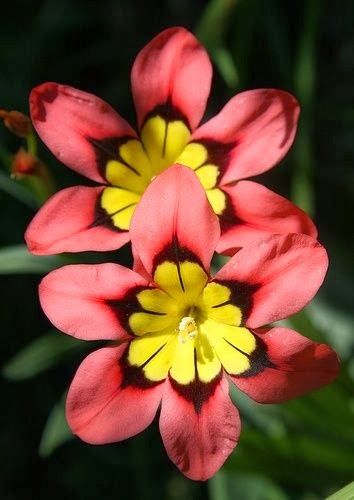Harlequin flower (Sparaxis tricolor)
Another discovery from Tumblr. I subscribe to several people there who regular blog about flowers and gardening and the photo below popped in my feed. I don’t know much about them, but this photo led to me find out a but more. This is always the great judge of any blog or blog post, the ability to move me to further research or action.
Discovered via Tumblr User FlowersGardenLove
Sparaxis (Harlequin Flower) is a genus in the family Iridaceae with about 13 species endemic to Cape Province, South Africa.
All are perennials that grow during the wet winter season, flower in spring and survive underground as dormant corms over summer. Their conspicuous flowers have six tepals, which in most species are equal in size and shape.
Sparaxis bulbifera is the commonest in cultivation, with flowers from cream to yellow or purple. S. grandiflora is a similar but larger plant. Sparaxis tricolor has bright red flowers with yellow and black centres. Many named hybrid cultivars were bred from S. bulbifera and S. tricolor.
A group of species with asymmetrical flowers marked in mauve and yellow, including Sparaxis variegata and Sparaxis villosa, was formerly treated as the genus Synnotia.
The genus name is derived from the Greek word sparasso, meaning “to tear”, and alludes to the shape of the floral bracts.[1] — Wikipedia
- Harlequin flower (Sparaxis tricolor) at Wikipedia
- Harlequin flower (Sparaxis tricolor) at Arkive.org
- Harlequin flower (Sparaxis tricolor) at Gardeners’s HQ
Previously in the Interesting Plant series:
- Erythronium
- Sempervivum
- Primula auricula
- Feathery Cassia (Senna auricula)
- Red Stick Dogwood (Cornus alba ‘Sibirica’)
- Japanese Maple (Acer palmatum)
- Kousa Dogwood (Cornus kousa)
- Giant Chalk Dudleya (Dudleya brittonii)
- Sunrose (Helianthemum nummularium)
- Australian/New Zealand Tea Tree (Leptospermum scoparium)
- Brugmansia Sanguinea
- Calico Monkeyflower (Mimulus pictus)
- Colocasia Esculenta
- Acer palmatum ‘Sango-kaku’ (Coral Bark Japanese Maple)
- Linderniaceae (formerly Torenia) Kuaui Deep Blue
- Passiflora (Passion flower)
- Firewheel Tree (Stenocarpus sinuatus)
- Anemone
- Allium Cowanii
- Symphyotrichum oblongifolius (Purple Aster)
- Hemerocallis ‘Derrick Cane’ (Daylily)
- Agastache ‘Aztec Rose’
- Rudbeckia hirta Moreno
- Kalanchoe Tomentosa
- Albuca namaquensis
- Hosta ‘Remember Me’
- Dahlia ‘Clair de Lune’
- Lovely silver-tinged fern on campus of Oberlin College, Ohio
- Tricolor Beech (Fagus sylvatica Purpurea Tricolor)
- Climbing Hydrangea (Hydrangea anomala petiolaris)
- Eremurus ‘Lemon Meringue’
- Lupine “Sunrise” (Lupinus hartwegii)
- Chinese Fringe Flower (Loropetalum chinense)
- Streptocarpus ‘Harlequin Blue’
- Nigella damascena (love-in-a-mist, ragged lady)
- Epiphyllum (Orchid Cactus)
- Sempervivum ‘Westerlin’
- Gladiolus ‘Kings Lynn’
- Hosta sieboldiana ‘Dorothy Benedict’
- Begonia “Escargot”
- Asparagus Pea (Psophocarpus tetragonolobus)
- Rosa banksiae (Lady Banks’ Rose)
- Primula ‘Victoriana Silver Laced Black’
- Oxalis versicolor
- Poached Egg Plant (Limnanthes douglasii)
- Parisian Carrots
- Fritillaria imperialis Rubra Maxima
- Clematis “Fascination”
- Swiss Chard “Bright Lights”
- Georgia Rattlesnake Melon
- Dianthus Barbathus “Green Ball” or “Green Trick”
- Coleus “Religious Radish”
- Black Forest Calla Lily
- Black Bamboo
Interesting Plant is a series from A Gardener’s Notebook blog and podcast that highlights the most interesting plants I find in my Internet and real-world travels — Douglas




